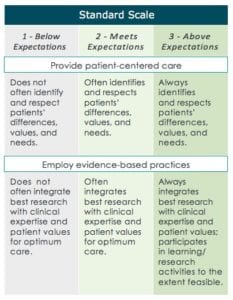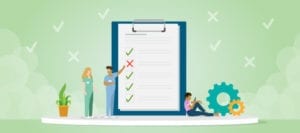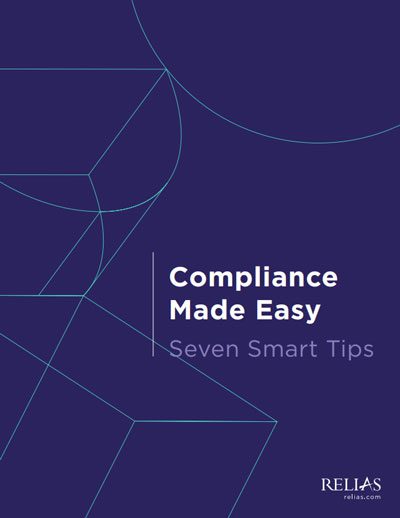Mmmm. Breathe deep. Can you smell it? Can you feel it? No, not the pumpkin lattes or sprigs of spruce and pine. It’s more like stale coffee and the gentle clicking of keys on the computer.
Yes! ‘Tis the season for evaluating training programs and checking everything twice to make sure you’re on the Center for Medicare and Medicaid Services’ and The Joint Commission’s nice lists.
To get you in the spirit, we’ve put together this blog, 12 Days of Compliance, to keep your organization on track through the rest of the year and into the new year.
Engage your employees
A huge part of keeping your organization compliant is making sure your staff is doing the same: completing their annual mandatories, utilizing the most current practices, following policies and procedures, and so on.
But with a shrinking pool of candidates and high turnover rates, competition is fierce to find and retain your employees.
Fostering employee engagement can increase retention and help keep your organization in compliance.
12. It’s game time

How do you motivate your staff to complete their training on time — especially when you’re trying to keep up with compliance? It’s not doughnuts. It’s gaming — gaming elements, that is.
The “gaming” in gaming elements can be misleading when used in the workplace, but don’t be fooled. It’s a valuable tool that can improve performance and compliance.
Now, we’re not talking about going full-on Mario or Settlers of Catan. But we suggest incorporating aspects that motivate behavior responses similar to when you’re playing a game.
Features like leaderboards and points can encourage friendly competition and empower staff to become active participants in their learning.
For example, staff members earn points when completing courses. They earn more if courses are completed early, if they complete more than one course, or if they receive high exam scores.
When you incentivize learning, your staff members complete their training because they want to, not because they have to. Gaming elements increase staff engagement, which results in improved knowledge retention, performance, and compliance.
11. M&M

While equally delightful, we’re not talking about the candy. We’re focused on two other M’s: micro-learning and mobile optimization. Why? Because convenient access to training is more important than ever.
Time is precious and finding a time for everyone to come into the office for live training is difficult. Your staff still may miss the live training event — for which instructors are specially paid and hired — and will have to find similar training off-site to remain compliant. This costs both the employee and employer time and money.
Providing online courses that are available 24/7 allows access anywhere at any time. Videotaping or recording live training events and uploading them to a learning management system prevents you from having to send employees off-site or schedule another training.
While this addresses accessibility, there’s still often another challenge associated with training.
Your staff is required to complete regular training, but how much of what they learn do they remember? Studies show that the answer to that question is concerning — we forget nearly 70 percent of what we learn in the first 24 hours.
Bridge the gap between completing required training and applying concepts to care delivery with mobile-optimized micro-learning: quick refreshers on training for your staff to access at the point of care. Short modules and quizzes will help your staff:
- Retain knowledge from their required training.
- Focus on the most critical skills to care for their specific patients.
- Access education and support when they need it.
These quick refreshers benefit your employees, those you care for, and your bottom line.
Your front-line staff is constantly on the go — whether from room to room within a facility or even from home to home, caring for individuals with a wide variety of needs. They’re not always right in front of a computer.
Micro-learning and courses with mobile optimization provide them with the support they need to provide the care your clients require and keep your organization compliant.
10. Get personal

Our society likes for things to be customized to our personal preferences. It makes each of us feel inherently special — “This item is prepared to suit me.”
Think about it — people customize their clothing, cars, and meal plans. So why don’t we apply this to training? In today’s world, the one-size-fits-all approach is going out of style.
It’s time we personalize training.
Consider your staff for a moment. You might have millennials looking to start their career, RNs with decades of experience, or seasoned acute clinicians that are new to the post-acute care space. Each of them has different educational needs.
Why would you provide them all with the same exact training plan?
The seasoned staff members may just need a refresher on the latest practice, whereas someone with less experience might need in-depth instruction on trach care. Tailor their education to their needs.
Utilize knowledge assessments to identify what areas are proficient and what areas need attention.
From there, create tailored training plans or assign specific courses to remediate any gaps in knowledge. This personalized approach makes the staff member feel valued and allows them to put all their cognitive energy into learning this specified information.
Because they are more engaged with this tailored education, it creates a better chance for successful processing and recalls later. This method also helps to establish a baseline competency by which you can measure and track progress over time.
Not only will you be meeting current regulatory requirements, but your employees will also be grateful that they don’t have to sit through information they already know, and you’ll save time and money in the process.
9. Did you get the memo?

Picture it: You’re happily sipping coffee, knocking out some work, when all of a sudden…Wham! Breaking news hits. A new state regulation has just been passed and goes into effect within the week. Your calm morning has just turned hectic.
Like lightning, you are executing a to-do list:
- Information gathered? Check!
- Plan created? Check!
- Approval gained? Check!
- Management informed? Check!
- Policies updated? Check!
You’ve got it all covered! Except for one tiny detail…you have to inform your entire staff of the updated policies and have each person attest to seeing it.
Your feeling of accomplishment fades, and panic starts to seep in.
How within a week’s time will you be able to inform all your staff? Not all of them have a corporate email account or even a personal email.
The best-made plans are laid to waste if there’s no effective communication from the top down within an accessible channel.
With so many changes to the post-acute landscape in the past couple of years, it’s critical that your teams be aware and informed of changes, both to the organization and their roles.
This change management tactic can prevent feelings of anxiety and uncertainty that can negatively fuel the fire of resentment, turnover, and burnout.
Be sure your organization has a fool-proof system in place to inform all employees of changes and a way to easily update, distribute and confirm witness to changes in policies and procedures.
Printing out memos and hanging them on every available surface is not a sustainable way to do this.
Online platforms offer a great alternative.
Learning management systems with built-in announcement features can reduce the time and costs of printouts and ensure that employees — even ones without corporate email addresses — can receive the information.
Similarly, digital policies and procedures are easier to update and distribute, especially within the same platform used to deliver announcements.
Keep your corporate compliance in check with an accessible mode of communication.
Measure your results
Compliance is about more than just yearly mandatory training. You stay compliant because you want to provide quality care, reduce risk and eliminate variations in care. To meet any of those goals, you need to be tracking your team’s performance. We don’t mean just monitoring what courses they’ve taken; you’ll do better to measure how much they actually retain and in what areas they need to improve. Read below to learn four ways to measure the effectiveness of your training, as we count down days 8 to 5.
8. Create baselines

Think about your favorite part of school. The thing you miss the most.
You’re probably thinking of your Ticonderoga #2 pencil scratching away while taking an exam, right?
OK, probably not.
But unlike certain standardized tests required of high school students, you should find assessments that will actually measure how much your staff knows about a wide range of job-related topics.
Here’s how it works.
You assign your staff member an assessment that will test their knowledge of job-specific skills.
You’ll get the results, which will show you what the staff member is good at and what they need additional training in. This will be your baseline.
Once you have a baseline in place, you’ll be able to identify gaps in their knowledge and assign courses to fill those gaps.
Maximize your staff’s time by giving them courses that fill gaps in their knowledge instead of wasting hours or days trying to teach them something they already know.
Work smarter, not harder. Your staff will appreciate not having to take the same course about the same topic they’ve already mastered, and you’ll be creating a stronger team.
Without a baseline in place, you will end up measuring the number of courses your staff members have taken. That tells only half the story.
Instead of being reactionary and holding trainings after a mistake happens, you can use assessments as a tool to identify potential issues before they negatively impact a patient.
Be proactive in measuring your staff’s knowledge using assessments.
7. Track competency
![]()
Tracking competency is easier said than done.
Numbers and spreadsheets can’t determine whether your team member is regularly employing person-centered care.
There isn’t a test you can put in front of them to know whether they’re employing best practices. That’s not an easy thing to measure because it requires observation.
So what is the best way to track competency development? Create customized proficiency standards and scales to help measure the things that aren’t easily quantifiable.

As you observe your staff working in their day-to-day jobs, you can keep track of how they are performing certain activities.
Assess them on your customized scale and identify strengths and weaknesses.
Creating proficiency standards will give you consistency in evaluation.
Every evaluator will know what it means to “meet expectations,” so you’ll be able truly determine the quality that each member of your staff is providing.
The first step in solving a problem is recognizing that you have one. Without measuring and tracking the competencies of your staff, how do you know if each staff member has sufficient skills for your case mix? How do you know if your training program is working?
By not employing this practice, you’re deciding not to measure important skills.
6. Demonstrate Skills

Online training is a fantastic tool for anyone in charge of managing compliance in your organization.
But it’s just one tool; it’s not the whole toolbox.
Don’t tell this to your friends who are teachers, but not everything can be measured with a multiple-choice test.
Sometimes you need your staff to be able to demonstrate their skills in person for certain tasks.
How will you know that your staff is properly washing their hands before working with those they care for?
You need to observe your staff member washing their hands before you can say for certain that they know the procedure.
The best way to measure and track these types of skills is by using checklists that are thorough and walk you through each step of the procedure.
Observe your staff members as they attempt to complete the task or series of tasks given and measure their performance against the checklist.
These kinds of checklists can be found online, or you can try to build them yourself.
After you observe, create records of a staff member’s ability to demonstrate specific job-related tasks to an approved observer.
Not only will you have confirmation that your staff members are following best practices, but you’ll have an electronic record of their competency.
You will be able to easily identify what tasks they are not properly trained on, and you will know down to the step where they are making mistakes.
In some cases, you don’t know what you can’t see. So it will pay off to find checklists that are designed for you to learn more about how your staff members work.
5. Customize and Automate Reporting

Too many organizations are relying on manually updating spreadsheets or stuffing their filing cabinets to track compliance.
What happens when your computer crashes or you misplace some of your papers?
Not creating an internet-based system to report on compliance puts your organization at risk. If you misplace the wrong piece of paper at the wrong time or forget to update the spreadsheet, that could be an issue.
An auditor or surveyor could come at any moment, so you need to be prepared to hand over all compliance-related information whenever someone asks for it.
With Relias’ reporting features, your information is just a few clicks away. Build customized reports that pull the information you need automatically.
No more ruffling through papers or creating complex formulas in your spreadsheets.
Without a solid reporting framework in place, you will be spending a lot of time manually tracking what has been completed by your staff.
Instead of taking up all your time tracking, spend your time on reporting and analyzing. Free yourself up to dig into the competency of your staff rather than waste your time manually collecting data.
Wouldn’t it be nice if you had the time to analyze where the strengths and weaknesses of your staff are?
Utilize automated reporting and put your resources toward building new plans rather than building spreadsheets.
Automate everything
Let’s face it, compliance is tough. Between turnover, regulatory updates, remote staff, and multiple facilities, you’re juggling a million things, and that doesn’t include your main priorities: patient outcomes or financial status.
Traditional methods of pen and paper or spreadsheets cost you time, resources, and money and open you up to risk. Technology allows you to build consistency and streamline practices and processes through automation — making compliance much more manageable. Read below to learn four ways technology can help check compliance off your list.

4. Automated onboarding

According to SHRM, 69% of employees are more likely to stay with a company for three years if they have a great onboarding experience.
One of the defining features of a great onboarding experience is organization.
You want to show your new employees that you have everything under control.
They’re entering a new environment bright-eyed and bushy-tailed, ready to conquer a new challenge.
If you spend the majority of their first day running around trying to figure out what they’re supposed to be doing, the excitement that they have about entering a new position is going to be drained quickly.
Instead of thinking “wow, this is where I belong,” they’ll be thinking something along the lines of “did I really leave my last job for this?”
One of the best ways to organize your onboarding and avoid any buyer’s remorse from your new staff member is through automation.
You need a system in place that will automatically send policies, procedures and trainings to new hires as soon as they enter the system based on their job role.
The next time you hire a nurse, they should automatically be assigned everything they need to complete with due dates.
No more shuffling through papers or hitting CTRL + F in your spreadsheet as part of your onboarding process.
This means that instead of taking up their first day frantically trying to remember what they’re supposed to be doing, you can take the time to get to know your new employee.
They’ll be spending their time thinking about how much they’re going to enjoy working with you, not making mental notes to look for a new job once they get home.
3. Content is king

Stop me if this sounds familiar.
It’s Monday morning. You get to the office and settle in. Coffee on your desk and croissant in your hand, you go through your email.
As you start to get your brain working on this fine Monday morning, you see everyone’s least favorite combination of words:
“CMS Announces…”
Here we go again.
You’ve got to figure out what the new regulations are, when they’re going to hit, and how to get your staff trained up to stay in compliance with the newest changes.
The video training you have isn’t up to date anymore. The person you bring in to train your staff in person might not update their presentation by the time you need training.
To stay compliant, you need access to the most up-to-date courses. You need a partner that is going to not just react to the latest changes in regulations, but proactively update their material to keep up with state and federal shifts.
That content should be given to you automatically. While you’re sleeping, they should be keeping their courses up to date.
As you evaluate training solutions, make sure you’re asking this question — what is your process for updating your courses?
If they don’t have a clear answer or aren’t regularly updating their course content, your staff isn’t being given what they need to stay compliant.
On top of just being out of compliance, giving your staff out-of-date training also means they’re not going to be providing the highest-quality care, which puts those you care for at risk.
Maximize your time and give your staff the tools they need to succeed with a partner that automatically updates their content for you.
2. Corporate compliance: your most important p’s (not paper)

Needless to say, corporate compliance is important. Policies and procedures management plays a huge role in this, but your maintenance method might be creating inefficiency and intentionally introducing risk. Let’s find out.
Can you answer yes to any of the following questions?
- Still keeping track of your policies and procedures by storing hard copies in large, dusty binders?
- Is it a hassle to make sure employees have reviewed and signed them to remain compliant?
- Trouble identifying which version of the procedures is the most current?
- Are you managing your policies and procedures manually?
If so, then it might be time to change things up. And believe us, friend, you are not alone.
Thankfully, there is absolutely a better way: Automate the process.
Say farewell to paper and hello to efficiency and consistency! Imagine it:
- No more heavy binders with outdated information
- Ability to upload, assign, review, and report on policies and procedures
- Clinical procedures that are always aligned with current best practices
- Confirmation of receipt of policies and procedures from everyone in your organization
- Efficient tracking and reporting of revisions and approvals for historical reference and liability reduction
Your time is valuable. By automating, you can help drive efficiency, improve compliance, and save time to focus on the most important thing — ensuring quality care.
A digital or online system can make policies and procedures management easily accessible, current, and consistent.
Establishing better operational efficiency by which you can upload, distribute, revise, and report on policies and procedures helps with onboarding and training, as well as making survey and audit preparation far less daunting.
But when making this transition, you’re going to want to consider the following:
- Version Control: Can you update documents as your policies and procedures change, upload new versions, change version numbers, and add notes? With so many regulatory changes in the industry, you need to be able to quickly and efficiently save versions as drafts for review and get them approved and published with the click of a button.
- Auto-Enrollment: New hires are costly and time-consuming. A system that can identify who matches specific staff profiles and auto-enroll them into the appropriate set of policies and procedures can streamline the process for you.
- Attestation Statements: Whether federally mandated or internally requested, enabling staff to read and “sign off” on policies and procedures can help to mitigate risk and keep you from spending hours tracking down each staff member.
- Reporting: Depending on your organization’s priorities, you may require reports on different data points. Consider your organization–assigned document or individual staff member? Whatever it is, make sure you can view a detailed breakdown of completion and compliance statistics.
- Permissions: Will you be able to specify which users can manage policies and procedures binders and the documents within them? This will help to maintain the integrity and consistency of the P&P.
Bottom line, it’s time to recycle the binders, pencils, and paper. An online policies and procedures management tool can significantly streamline your ability to track, assign, update, and report on policies and procedures, saving your organization valuable time and resources.
1. One robust, magical platform

“Platform” is something we hear quite often in IT, and it’s becoming ever more prevalent in healthcare. These online systems might be described as “robust” or “comprehensive.”
These words are just enough to give a general idea of what they mean, but it’s vague enough that you don’t totally know what it does. Think of it this way: platforms are kind of like a house. Sounds a bit bizarre, but let’s break this down.
Beds are a wonderful thing.
So are dishwashers and couches and washers and dryers.
These are all tools that make your life easier, but without a home to put them in, they’re not very helpful.
From this lens, platforms are the framework (or foundation) by which to build upon and leverage additional technology. So in healthcare, a platform might include a learning management system in addition to other tools.
When you’re “house” shopping, you’re considering the size and scope of the home and asking yourself: Do I want a condo? Studio? 2-bedroom apartment? Beach house?
You’re considering the amenities: AC, electric vs. gas heating, washer, dryer, etc.
It’s important to do the same when shopping around for a new platform: Does it have automatic tracking? Custom reporting? Include educational content? CEs? HRIS integration?
Like purchasing a house, price is always a factor. Much like buying a fixer-upper verses a ready to move-in home, there are time and cost savings to think about.
While the fixer-upper might cost less, you’re going to be putting a lot more time and money into getting it to be what you want — and let’s face it, it might never get there. A ready to move in home might cost more, but it’s more a matter of putting on a fresh coat of paint and you’re set.
Think about it this way. You rent an apartment without a washing machine and a dryer.
Every Tuesday, you now have to load up the car, drive to the laundromat, forget your quarters, drive back home, drive back to the laundromat, and wash your clothes.
Did your clothes still get washed? Yes.
Did you spend 3 hours at a laundromat when you could’ve been watching TV on your couch? Also yes.
It’s the same concept when thinking about a learning management platform.
Can you track compliance without one? Yes.
Will your life be much easier having everything in one place? Of course it will.
Similar to homes, it’s important to think about a platform as an investment toward your long-term goals.
When it comes to compliance, these platforms can automate tracking and reporting, streamline processes, create consistency, enhance training, and improve performance, making compliance nearly a breeze.
Compared to traditional methods of pen and paper or spreadsheets, a holistic platform can be downright magical.
Editor’s Note: This post was originally published in three-part blog series in December 2019 and has been updated with new content.

Compliance Made Easy
Download our Compliance Made Easy e-book for seven smart tips to help your organization stay compliant without added stress.
Download the E-Book →





